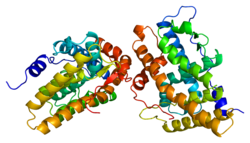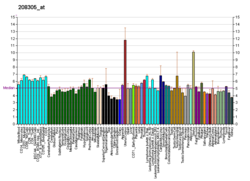プロゲステロン受容体
プロゲステロン受容体(Progesterone receptor;PR)は、NR3C3(核内受容体サブファミリー3、グループC、メンバー3)とも呼ばれる、細胞内に存在するタンパク質である。ステロイドホルモンであるプロゲステロンによって活性化される。
ヒトでは、染色体11q22に存在する1つのPGR 遺伝子にコードされており[5][6][7]、分子量の異なる3つのアイソフォーム、PR-A、PR-B、PR-Cが存在する[8][9][10]。PR-Bはプロゲステロンの作用を上方制御し、PR-AはPR-Bの効果を抑制する役割を担っている[11]。
機序
[編集]プロゲステロン受容体の誘導には、プロゲステロンを必要とする。結合するホルモンが存在しない場合、カルボキシル末端は転写を阻害する。ホルモンに結合すると構造変化が起こり、抑制作用が解除される。プロゲステロン阻害薬は構造的再構成を抑制する。
プロゲステロンが受容体に結合した後、二量体化を伴う再構築が起こり、複合体は核に入りDNAに結合する。そこで転写が行われ、伝令RNAが形成され、リボソームによって翻訳され、特定のタンパク質が作られる。
構造
[編集]| プロゲステロン受容体N末端 | |||||||||
|---|---|---|---|---|---|---|---|---|---|
| 識別子 | |||||||||
| 略号 | Progest_rcpt_N | ||||||||
| Pfam | PF02161 | ||||||||
| InterPro | IPR000128 | ||||||||
| |||||||||
他のステロイド受容体と同様に、プロゲステロン受容体は、N末端の調節ドメイン、DNA結合ドメイン、ヒンジ部、C末端のリガンド結合ドメインから構成されている。プロゲステロン受容体Bには、TAF-3と呼ばれる特殊な転写活性化機能(TAF)が、アミノ酸末端のB上流セグメント(BUS)に存在する。このセグメントは受容体Aには存在しない。
アイソフォーム
[編集]プロゲステロン受容体欠損マウスで実証された通り、プロゲステロンの生理作用は核内受容体のステロイド受容体スーパーファミリーの一員であるヒトプロゲステロン受容体(hPR)の存在に完全に依存している。シングルコピーのhPR遺伝子は、別々のプロモーターと翻訳開始点を用いて、2つのアイソフォーム、hPR-Aと-Bを生成する。hPR-BのN末端のみに165アミノ酸が追加されている以外は同一のものである[12]。hPR-BはhPR-Aと多くの重要な構造ドメインを共有しているが、実際には機能的に異なる2つの転写因子であり、それぞれの応答遺伝子と生理作用をほとんど重複なく媒介する。PR-Aを欠損させたマウスモデルでは、PR-Bのみが産生され、PR-Bはエストロゲン単独またはプロゲステロンとエストロゲンの存在下で、上皮細胞の増殖を抑制するのではなく、むしろ寄与することが予想外に明らかにされた。これらの結果は、子宮においてPR-AアイソフォームはPR-B依存性の増殖だけでなく、エストロゲン誘導性の増殖にも対抗するために必要であることを示唆している。
機能的多型
[編集]ヒトのPR遺伝子には、4つの多型と5つの共通ハプロタイプを含む6つの可変部位が同定されている[13]。プロモーター領域の多型の1つである+331G/Aは、ユニークな転写開始部位を作り出している。生化学的アッセイにより、+331G/A 多型は PR 遺伝子の転写を増加させ、石川県子宮内膜癌細胞株における hPR-B の産生を促進することが示された[14]。
現在、いくつかの研究で、プロゲステロン受容体遺伝子の+331G/A多型と乳癌や子宮内膜癌との関連はないことが示されている[15][16]。しかし、これらの追跡調査は、+331A SNPの希少性により、決定的な結論を出すには標本数と統計的検出力が不足している。現在、この受容体のどの多型が癌に重要であるかは不明である。欧州以外の21の集団を対象とした研究で、PR遺伝子のPROGINSハプロタイプ内の2つのマーカーが、卵巣癌および乳癌と正の相関があることが同定された[17]。
動物研究
[編集]発達
[編集]PRのノックアウトマウスでは、乳腺の小葉腺胞の発達が著しく損なわれ[18]、思春期には乳管の発達が遅れるが最終的に正常に成熟することが判明している[19][20]。
行動
[編集]ネズミの周産期には、プロゲステロン受容体(PR)が中脳皮質ドーパミン経路の腹側被蓋野(VTA)と内側前頭前野(mPFC)の両方で一過性に発現することが知られている。この時期のPRの活性は、VTAからmPFCへのドーパミン神経支配の発達に影響を与える。PR活性が変化すると、mPFCのドーパミン神経支配に変化が見られ、VTAのドーパミン合成の律速酵素であるチロシン水酸化酵素(TH)にも影響が現れる。この領域におけるTHの発現は、ドーパミン作動性活性の指標であり、ワーキングメモリー、注意、行動抑制、認知柔軟性など、中脳皮質ドーパミン経路を介した複雑な認知行動の正常かつ重要な発達に関与していると考えられる[21]。
新生仔期のラットにRU 486などのPR拮抗薬を投与すると、PR免疫活性(PR-ir)と強く共発現するチロシン水酸化酵素免疫活性(TH-ir)細胞密度の低下が幼若期のラットの大脳皮質で見られることが研究により明らかにされている。その後、成体では、VTAにおけるTH-irの減少も示される。このTH-ir線維発現の変化は、新生児期のPR拮抗薬投与によるドーパミン作動性活性の変化の指標であり、その後、成体における行動抑制や衝動性を測定するタスクの成績や、認知の柔軟性を損なうことが示されている。PRノックアウトマウスにおいても、VTAにおけるドーパミン活性の低下により、同様の認知的柔軟性の障害が認められた[21]。
逆に、中脳皮質ドーパミン経路が発達する周産期に、17α-ヒドロキシプロゲステロンカプロエートなどのPR作動薬をネズミに投与すると、mPFCへのドーパミン神経支配が増加する。その結果、TH-ir線維密度も増加する。このTH-ir線維とドーパミン作動性活性の増加は、後年、固執性が増して認知的柔軟性が損なわれることとも関連している[22]。
これらの知見は、ネズミの初期発生におけるPRの発現が、その後の認知機能に影響を与えることを示唆している。さらに、中脳皮質ドーパミン神経経路の発達の重要な時期にPR活性のレベルが異常になると、その後の複雑な認知行動の形成に関わる特定の行動神経回路に大きな影響を与える可能性があるように思われる[21][22]。
リガンド
[編集]作動薬
[編集]混合作用
[編集]拮抗薬
[編集]相互作用
[編集]プロゲステロン受容体は、下記の分子と相互作用する。
関連項目
[編集]出典
[編集]- ^ a b c GRCh38: Ensembl release 89: ENSG00000082175 - Ensembl, May 2017
- ^ a b c GRCm38: Ensembl release 89: ENSMUSG00000031870 - Ensembl, May 2017
- ^ Human PubMed Reference:
- ^ Mouse PubMed Reference:
- ^ “Complete amino acid sequence of the human progesterone receptor deduced from cloned cDNA”. Biochemical and Biophysical Research Communications 143 (2): 740–8. (March 1987). doi:10.1016/0006-291X(87)91416-1. PMID 3551956.
- ^ “The progesterone receptor gene maps to human chromosome band 11q13, the site of the mammary oncogene int-2”. Proceedings of the National Academy of Sciences of the United States of America 84 (9): 2877–81. (May 1987). Bibcode: 1987PNAS...84.2877L. doi:10.1073/pnas.84.9.2877. PMC 304763. PMID 3472240.
- ^ “Ensembl genome browser 54: H.sapiens - Gene summary - Gene: PGR (ENSG00000082175)”. may2009.archive.ensembl.org. 2022年1月5日閲覧。
- ^ “Progesterone receptors: various forms and functions in reproductive tissues”. Frontiers in Bioscience 10 (1–3): 2118–30. (2005). doi:10.2741/1685. PMID 15970482.
- ^ Kase, Nathan G.; Speroff, Leon; Glass, Robert L. (1999). Clinical gynecologic endocrinology and infertility. Hagerstown, MD: Lippincott Williams & Wilkins. ISBN 978-0-683-30379-7
- ^ Fritz, Marc A.; Speroff, Leon (2005). Clinical gynecologic endocrinology and infertility. Hagerstown, MD: Lippincott Williams & Wilkins. ISBN 978-0-7817-4795-0
- ^ Falcone, Tommaso; Hurd, William W. (22 May 2013). Clinical Reproductive Medicine and Surgery: A Practical Guide. Springer Science & Business Media. pp. 39–. ISBN 978-1-4614-6837-0
- ^ “Two distinct estrogen-regulated promoters generate transcripts encoding the two functionally different human progesterone receptor forms A and B”. The EMBO Journal 9 (5): 1603–14. (May 1990). doi:10.1002/j.1460-2075.1990.tb08280.x. PMC 551856. PMID 2328727.
- ^ “Genetic variation in the progesterone receptor gene and ovarian cancer risk”. American Journal of Epidemiology 161 (5): 442–51. (March 2005). doi:10.1093/aje/kwi064. PMC 1380205. PMID 15718480.
- ^ “A functional polymorphism in the promoter of the progesterone receptor gene associated with endometrial cancer risk”. Proceedings of the National Academy of Sciences of the United States of America 99 (19): 12263–8. (September 2002). Bibcode: 2002PNAS...9912263D. doi:10.1073/pnas.192172299. PMC 129433. PMID 12218173.
- ^ “No association between the progesterone receptor gene +331G/A polymorphism and breast cancer”. Cancer Epidemiology, Biomarkers & Prevention 13 (6): 1084–5. (June 2004). PMID 15184270.
- ^ “No association between progesterone receptor gene +331G/A polymorphism and endometrial cancer”. Cancer Epidemiology, Biomarkers & Prevention 15 (7): 1415–6. (July 2006). doi:10.1158/1055-9965.EPI-06-0215. PMID 16835347.
- ^ Rockwell, L. C.; Rowe, E. J.; Arnson, K.; Jackson, F.; Froment, A.; Ndumbe, P.; Seck, B.; Jackson, R. et al. (2012). “Worldwide distribution of allelic variation at the progesterone receptor locus and the incidence of female reproductive cancers”. American Journal of Human Biology 24 (1): 42–51. doi:10.1002/ajhb.21233. PMID 22121098.
- ^ “Mammary gland development”. Wiley Interdisciplinary Reviews. Developmental Biology 1 (4): 533–57. (2012). doi:10.1002/wdev.35. PMC 3404495. PMID 22844349.
- ^ “Minireview: Progesterone Regulation of Proliferation in the Normal Human Breast and in Breast Cancer: A Tale of Two Scenarios?”. Molecular Endocrinology 29 (9): 1230–42. (September 2015). doi:10.1210/me.2015-1152. PMC 5414684. PMID 26266959.
- ^ “Amphiregulin mediates progesterone-induced mammary ductal development during puberty”. Breast Cancer Research 15 (3): R44. (May 2013). doi:10.1186/bcr3431. PMC 3738150. PMID 23705924.
- ^ a b c “Progesterone Receptor Expression in the Developing Mesocortical Dopamine Pathway: Importance for Complex Cognitive Behavior in Adulthood”. Neuroendocrinology 103 (3–4): 207–22. (2016). doi:10.1159/000434725. PMC 4675705. PMID 26065828.
- ^ a b “Exposure to the Synthetic Progestin, 17α-Hydroxyprogesterone Caproate During Development Impairs Cognitive Flexibility in Adulthood”. Endocrinology 157 (1): 77–82. (January 2016). doi:10.1210/en.2015-1775. PMC 4701880. PMID 26556535.
- ^ a b “Tracking progesterone receptor-mediated actions in breast cancer”. Pharmacology & Therapeutics 142 (1): 114–25. (April 2014). doi:10.1016/j.pharmthera.2013.11.010. PMC 3943696. PMID 24291072.
- ^ “Selective interactions of Kruppel-like factor 9/basic transcription element-binding protein with progesterone receptor isoforms A and B determine transcriptional activity of progesterone-responsive genes in endometrial epithelial cells”. The Journal of Biological Chemistry 278 (24): 21474–82. (June 2003). doi:10.1074/jbc.M212098200. PMID 12672823.
- ^ “The opposing transcriptional activities of the two isoforms of the human progesterone receptor are due to differential cofactor binding”. Molecular and Cellular Biology 20 (9): 3102–15. (May 2000). doi:10.1128/MCB.20.9.3102-3115.2000. PMC 85605. PMID 10757795.
- ^ “The Angelman syndrome-associated protein, E6-AP, is a coactivator for the nuclear hormone receptor superfamily”. Molecular and Cellular Biology 19 (2): 1182–9. (February 1999). doi:10.1128/mcb.19.2.1182. PMC 116047. PMID 9891052.
関連資料
[編集]- “Progesterone receptor activity in leiomyomatosis peritonealis disseminata”. International Journal of Gynecological Pathology 18 (3): 259–64. (July 1999). doi:10.1097/00004347-199907000-00012. PMID 12090595.
- “Progesterone receptor transcription and non-transcription signaling mechanisms”. Steroids 68 (10–13): 761–70. (November 2003). doi:10.1016/S0039-128X(03)00129-6. PMID 14667966.
- “Progesterone-dependent regulation of female reproductive activity by two distinct progesterone receptor isoforms”. Steroids 68 (10–13): 771–8. (November 2003). doi:10.1016/S0039-128X(03)00126-0. PMID 14667967.
- “Ligand and DNA-dependent phosphorylation of human progesterone receptor in vitro”. Proceedings of the National Academy of Sciences of the United States of America 89 (7): 2664–8. (April 1992). Bibcode: 1992PNAS...89.2664B. doi:10.1073/pnas.89.7.2664. PMC 48722. PMID 1557371.
- “Two distinct estrogen-regulated promoters generate transcripts encoding the two functionally different human progesterone receptor forms A and B”. The EMBO Journal 9 (5): 1603–14. (May 1990). doi:10.1002/j.1460-2075.1990.tb08280.x. PMC 551856. PMID 2328727.
- “Mechanisms of nuclear localization of the progesterone receptor: evidence for interaction between monomers”. Cell 57 (7): 1147–54. (June 1989). doi:10.1016/0092-8674(89)90052-4. PMID 2736623.
- “The interaction of canrenone with oestrogen and progesterone receptors in human uterine cytosol”. British Journal of Clinical Pharmacology 15 (1): 95–101. (January 1983). doi:10.1111/j.1365-2125.1983.tb01470.x. PMC 1427833. PMID 6849751.
- “Sequence and characterization of a coactivator for the steroid hormone receptor superfamily”. Science 270 (5240): 1354–7. (November 1995). Bibcode: 1995Sci...270.1354O. doi:10.1126/science.270.5240.1354. PMID 7481822.
- “Identification of phosphorylation sites unique to the B form of human progesterone receptor. In vitro phosphorylation by casein kinase II”. The Journal of Biological Chemistry 269 (49): 31034–40. (December 1994). doi:10.1016/S0021-9258(18)47386-3. PMID 7983041.
- “No evidence for the expression of the progesterone receptor on peripheral blood lymphocytes during pregnancy”. Human Reproduction 9 (8): 1546–9. (August 1994). doi:10.1093/oxfordjournals.humrep.a138746. PMID 7989520.
- “Negative interaction between the RelA(p65) subunit of NF-kappaB and the progesterone receptor”. The Journal of Biological Chemistry 271 (11): 6217–24. (March 1996). doi:10.1074/jbc.271.11.6217. PMID 8626413.
- “Progesterone receptor immunoreactivity at the maternofetal interface of first trimester pregnancy: a study of the trophoblast population”. Human Reproduction 11 (2): 413–9. (February 1996). doi:10.1093/humrep/11.2.413. PMID 8671234.
- “Differential interaction of nuclear receptors with the putative human transcriptional coactivator hTIF1”. The Journal of Biological Chemistry 272 (18): 12062–8. (May 1997). doi:10.1074/jbc.272.18.12062. PMID 9115274.
- “Steroid receptor induction of gene transcription: a two-step model”. Proceedings of the National Academy of Sciences of the United States of America 94 (15): 7879–84. (July 1997). Bibcode: 1997PNAS...94.7879J. doi:10.1073/pnas.94.15.7879. PMC 21523. PMID 9223281.
- “Expression of progesterone receptor mRNA in the first trimester human placenta”. Biochemistry and Molecular Biology International 42 (6): 1235–40. (September 1997). doi:10.1080/15216549700203701. PMID 9305541.
- “Progesterone receptor variants found in breast cells repress transcription by wild-type receptors”. Breast Cancer Research and Treatment 48 (3): 231–41. (April 1998). doi:10.1023/A:1005941117247. PMID 9598870.
- “Atomic structure of progesterone complexed with its receptor”. Nature 393 (6683): 392–6. (May 1998). Bibcode: 1998Natur.393..392W. doi:10.1038/30775. PMID 9620806.
- “High-mobility group chromatin proteins 1 and 2 functionally interact with steroid hormone receptors to enhance their DNA binding in vitro and transcriptional activity in mammalian cells”. Molecular and Cellular Biology 18 (8): 4471–87. (August 1998). doi:10.1128/mcb.18.8.4471. PMC 109033. PMID 9671457.
- “The Angelman syndrome-associated protein, E6-AP, is a coactivator for the nuclear hormone receptor superfamily”. Molecular and Cellular Biology 19 (2): 1182–9. (February 1999). doi:10.1128/mcb.19.2.1182. PMC 116047. PMID 9891052.
外部リンク
[編集]- Progesterone Receptors - MeSH・アメリカ国立医学図書館・生命科学用語シソーラス






